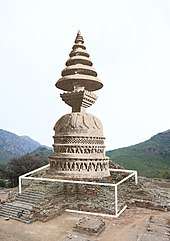Bhamala Stupa
| Bhamala Stupa بهامالا اسٹوپ | |
|---|---|
 | |
 Shown within Pakistan | |
| Basic information | |
| Location |
Haripur Khyber Pakhtunkhwa Pakistan |
| Geographic coordinates | 33°50′N 72°58′E / 33.833°N 72.967°E |
| Affiliation | Buddhism |
| Province | Khyber Pakhtunkhwa |
| Year consecrated | 4th century CE |
Bhamala Stupa (Urdu: بهامالا اسٹوپ) is a ruined Buddhist stupa and National Heritage Site near Haripur, Pakistan that dates to the 4th century CE. Bhamala stupa is part of the larger Bhamala Buddhist Complex.[1] The site is known for its 1,700 statue of the Buddha attaining enlightenment - considered the oldest such statue in the world.[2]
Excavation

Sir Sufian Malik and Sir John Marshall first excavated the site in 1929,[2] and work continued until the early 1930s. Excavations resumed in 2017.[2] It is nominated at UNESCO World Heritage Sites. The nomination lead to the restoration of the ruins (mainly the Stupa). The site , as of June 2015, is under the control of Department of Archaeology and Museums, Government of Khyber Pakhtunkhwa, Government of Pakistan. The site is believed to be one of the best preserved sites in the Taxila Valley.[1]
The stupa has a characteristic cruciform plan, with flights of stairs in the four cardinal directions, which is one of the last steps of the evolution of the Gandhara stupa, the preceding steps being:
1) the Dharmarajika Stupa with a near-Indian design of a semi-hemispheric stupa almost directly on the ground surface,
2) the Classic Loriyan Tangai Stupa, with a elongated shape and many narrative reliefs,
3) the near-pyramidal Jaulian stupa.[3]
The cruciform design further evolved to the towering design of the second Kanishka stupa.[3]
The Bhamala stupa is dated to the 4th-5th century CE.[3]
Specifications
According to the current understandings, the shape of main stupa is cruciform and it is the biggest surviving example of this shape in Taxila and Gandhara region. The stupa is cross shaped and looks like an Aztec Pyramid. There are about nineteen but small votive stupas in courtyard surrounding the main stupa.[1]
- A view of the ruins.
 Stonework.
Stonework. Bhamala stupa Buddha statues.
Bhamala stupa Buddha statues. Smaller votive stupas.
Smaller votive stupas. Monastery.
Monastery. Monastery cells.
Monastery cells.
 A Gandharan sculpture being excavated.
A Gandharan sculpture being excavated.
See also
| Wikimedia Commons has media related to Bhamala Stupa, Haripur. |
References
- 1 2 3 "Hazara University Department of Archaeology". Huarchaeology.org. Archived from the original on 2014-07-03.
- 1 2 3 https://www.theguardian.com/world/2017/nov/15/pakistan-unveils-remains-of-1700-year-old-sleeping-buddha
- 1 2 3 4 After Le Huu Phuoc, Buddhist Architecture, Grafikol 2009, p.179